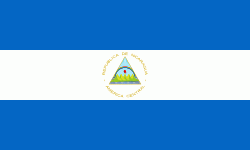San Lorenzo (Municipio de San Lorenzo)
San Lorenzo is a municipality in the Boaco Department of Nicaragua. It has a population of 28,100 (2006, est.) and an extension of 559.61 km2. The economy is based mainly on agricultural and some agropecuarian activities. The capital is the town of San Lorenzo located 91 km from Managua.
Most people in the municipality (70%) lives in rural areas. The mayor of the municipality of San Lorenzo is Leonel Leonidas Sasiga Madrigal from the Constitutionalist Liberal Party (PLC).
Back in 1852, Josefa Tellez, owner of a small farm in the vicinity of the area where the town of San Lorenzo is located today, found a religious image of San Lorenzo. From that day the place was known as San Lorenzo de los Tellez in honor to Josefa Tellez.
San Lorenzo was officially granted the title of town on August 23, 1858. With new settlers from Granada Department in 1872, the town became more populated. The municipality of San Lorenzo was part of the Chontales Department until 1935, when it became part of the Boaco Department.
Most people in the municipality (70%) lives in rural areas. The mayor of the municipality of San Lorenzo is Leonel Leonidas Sasiga Madrigal from the Constitutionalist Liberal Party (PLC).
Back in 1852, Josefa Tellez, owner of a small farm in the vicinity of the area where the town of San Lorenzo is located today, found a religious image of San Lorenzo. From that day the place was known as San Lorenzo de los Tellez in honor to Josefa Tellez.
San Lorenzo was officially granted the title of town on August 23, 1858. With new settlers from Granada Department in 1872, the town became more populated. The municipality of San Lorenzo was part of the Chontales Department until 1935, when it became part of the Boaco Department.
Map - San Lorenzo (Municipio de San Lorenzo)
Map
Country - Nicaragua
 |
 |
| Flag of Nicaragua | |
Originally inhabited by various indigenous cultures since ancient times, the region was conquered by the Spanish Empire in the 16th century. Nicaragua gained independence from Spain in 1821. The Mosquito Coast followed a different historical path, being colonized by the English in the 17th century and later coming under British rule. It became an autonomous territory of Nicaragua in 1860 and its northernmost part was transferred to Honduras in 1960. Since its independence, Nicaragua has undergone periods of political unrest, dictatorship, occupation and fiscal crisis, including the Nicaraguan Revolution of the 1960s and 1970s and the Contra War of the 1980s.
Currency / Language
| ISO | Currency | Symbol | Significant figures |
|---|---|---|---|
| NIO | Nicaraguan córdoba | C$ | 2 |
| ISO | Language |
|---|---|
| EN | English language |
| ES | Spanish language |















